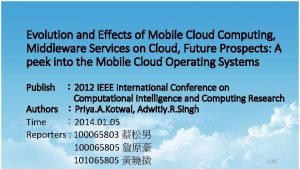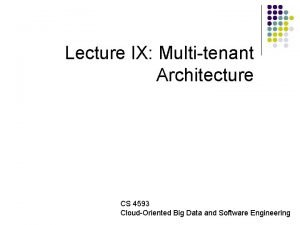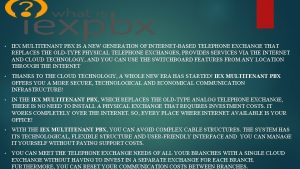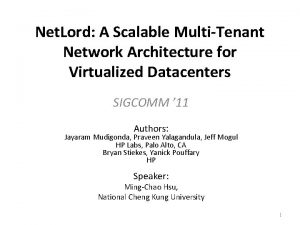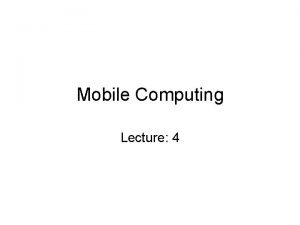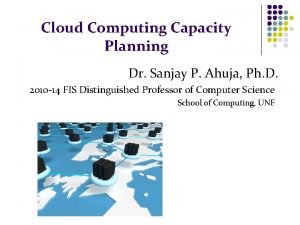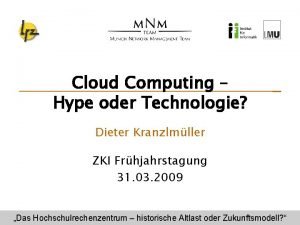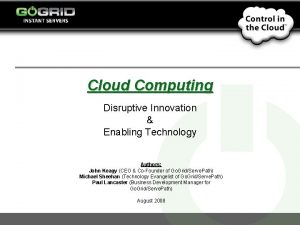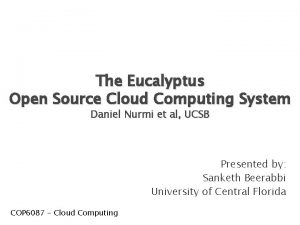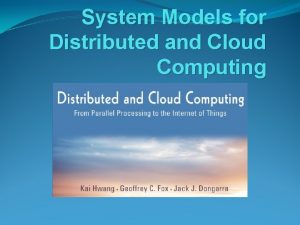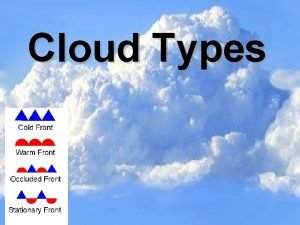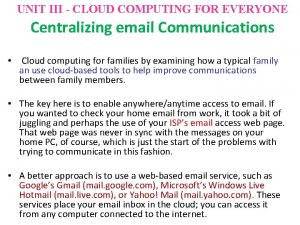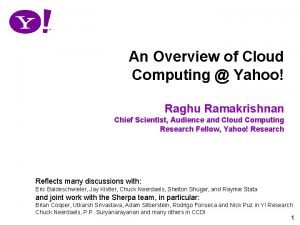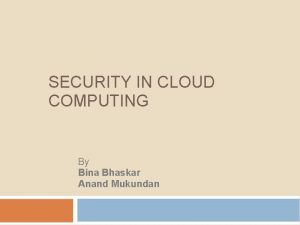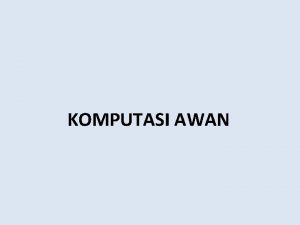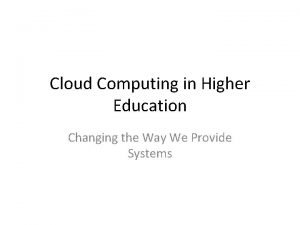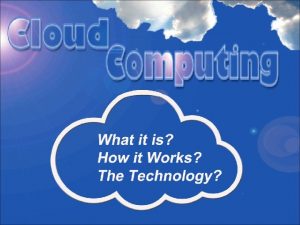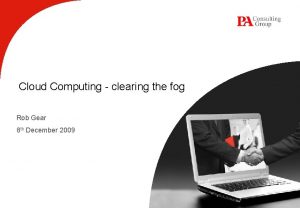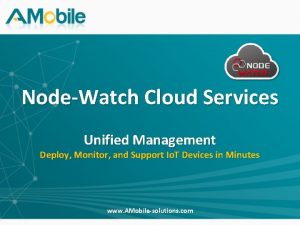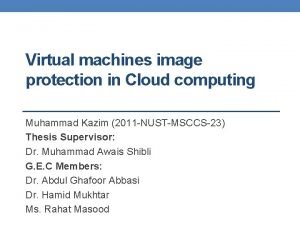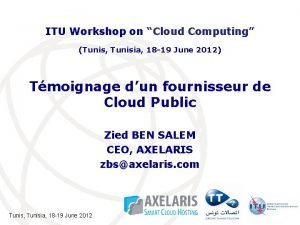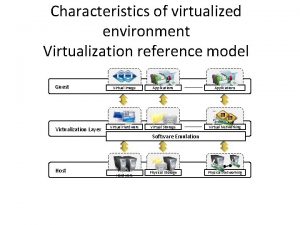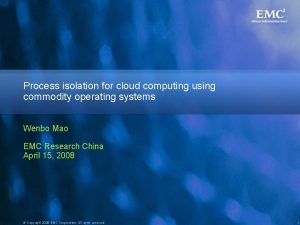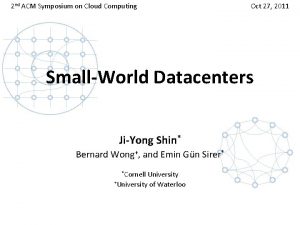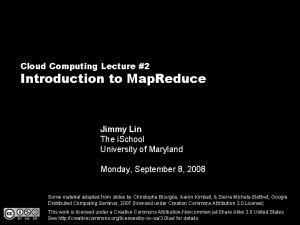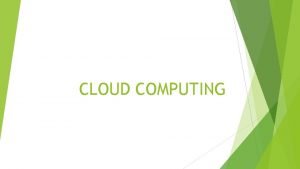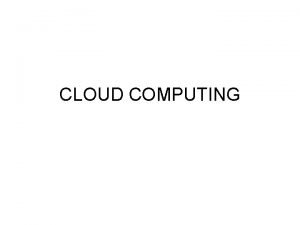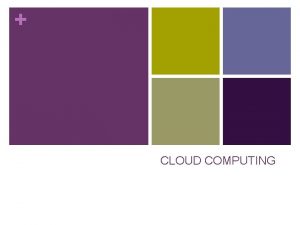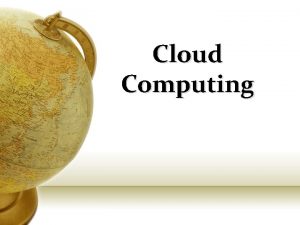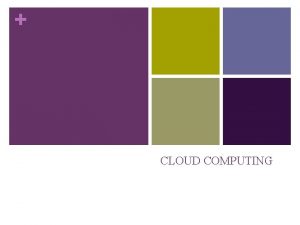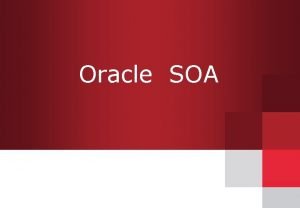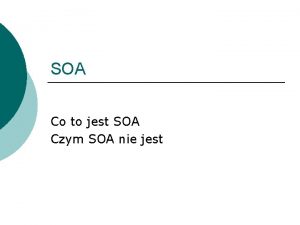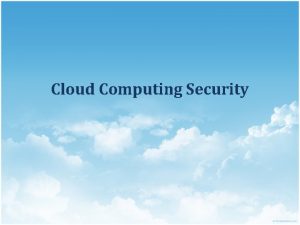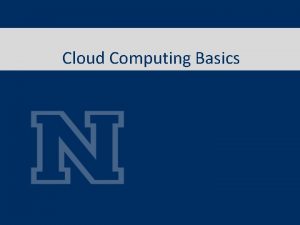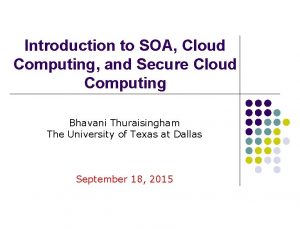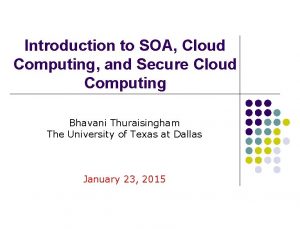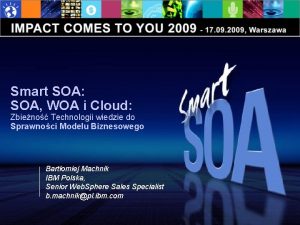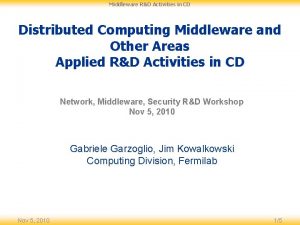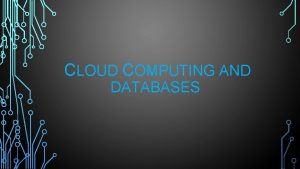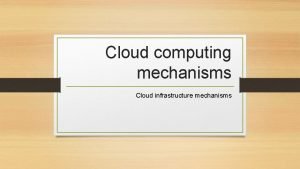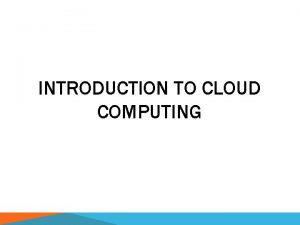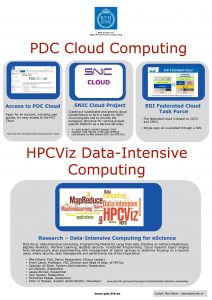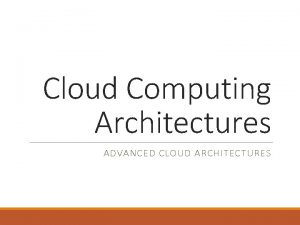MultiTenant SOA Middleware for Cloud Computing Afkham Azeez



























- Slides: 27

Multi-Tenant SOA Middleware for Cloud Computing Afkham Azeez, Srinath Perera, Dimuthu Gamage, Ruwan Linton, Prabath Siriwardana, Dimuthu Leelaratne, Sanjiva Weerawarana, Paul Fremantle WSO 2 Inc. Mountain View, CA, USA 报告人:陈大鹏

INTRODUCTION • Cloud computing:inadequate to provide major cost savings across the IT infrastructure life-cycle • User’s wish is to outsource their complete IT infrastructure as a service, whereas cloud computing only provides much lower levels of virtualization. • Solution:Saa. S • Saa. S has not realized outsourcing Service Oriented Architecture artifacts • Solution:Paa. S • The next level of Paa. S:virtualization, elasticity and multi-tenancy • Future:virtualize the middleware servers that are running the SOA artifacts

INTRODUCTION • There have been many efforts to build multi-tenant frameworks, and most efforts have been focused on providing data multi-tenancy • This paper presents an architecture that enables multitenancy at the SOA platform level, which enable users to run SOA artifacts in a multi-tenant SOA framework. This framework becomes a platform for building multi-tenant Saa. S applications

RELATED WORK • Data multi-tenancy: • three main approaches for data management:separate databases, shared database with separate schemas and shared database with shared schemas • a maturity model of multi-tenant applications(4 levels) level 1 an instance per tenant level 2 a configurable instance per tenant level 3 single instance serves customers level 4 enables level 3 to scale up by running multiple instances and load balancing to scale it up • Our proposed solution falls under multi-user single instance.

MULTI-TENANCY IN SOA high level multi-tenancy architecture

MULTI-TENANCY IN SOA • Services are grouped under Execution, Security, and Data. • Execution involves developing, deploying and running services, and composing those services together to create higher level artifacts • Security services define the ownership and authorization of both data as well as executions in the framework. • providing an isolated space per tenant/users in the SOA framework is a challenging problem. • Tenants’ two level of access control

PROPOSED ARCHITECTURE • The proposed solution is implemented on top of the WSO 2 Carbon platform • We discuss different aspects of the system architecture • • • WSO 2 Carbon platform Service deployment Message dispatching Security Service execution Data access

WSO 2 Carbon Platform • The WSO 2 Carbon platform consists of a full suite of products: • • WSO 2 Application Server for service hosting (Web Apps, JAX-WS, Axis 2, Spring) WSO 2 Enterprise Service Bus for mediation services (and SAP, FIX, HL 7, Salesforce. com adapters) WSO 2 Message Broker for messaging services (AMQP, JMS, Amazon SQS, WS-Eventing) WSO 2 Data Services Server for managing data sources and data access (No. SQL, RDBMS, Flat file, CVS, MS-Excel, Google Docs) WSO 2 Identity Server for authentication, single sign-on and access control (SAML 2. 0, Open. ID, OAuth, XACML, WS-Security) WSO 2 Governance Registry and repository for managing WSDL, schemas, policies, life cycles and versioning WSO 2 Business Process Server(BPEL), WSO 2 Business Rules Server (JSR-94), WSO 2 Complex Event Processing Server, WSO 2 Business Activity Monitor (JMX) and WSO 2 Mashup Server for composing, orchestrating and monitoring business processes and activities. WSO 2 Gadget Server for portal services WSO 2 Web Services Frameworks for C, C++ and PHP – provide simple APIs for implementing web services and web service clients • • •

WSO 2 Carbon Platform • WSO 2 Carbon is a Java based platform, a open source componentized middleware framework for building servers • • The servers consist of components which fit into the framework The servers depend on the services provided by the framework The servers offer a Web services API for management The servers offer components which fit into the Carbon administration console to interact with the services and manage themselves • The component model used by WSO 2 Carbon is OSGi

WSO 2 Carbon Platform • The platform consists of three components: the WSO 2 Carbon core, the management console, components that execute within the framework. • The WSO 2 Carbon core is the main engine of WSO 2 Carbon and manages the loading, linking, execution and management of WSO 2 Carbon Components. • The WSO 2 Carbon core offers a set of services for components executing in it

WSO 2 Carbon Platform • authentication and authorization management for administrative services of the components • authentication and authorization for services offered by the component, including full user management and role based authorization • shared repository to store state on a per-server basis • shared repository to store cluster-wide configuration state • shared registry to store system governance information and to look up data and metadata for runtime governance • services to share runtime data across nodes in a cluster • UI framework for writing UI components to give a human interface to the administrative services of components

WSO 2 Carbon Platform • WSO 2 Carbon components are OSGi bundles • Components can be grouped into the concept of “features” • WSO 2 Carbon based server is basically a collection of features that have been preconfigured to start at the same time • Features can be brought into the server and removed from the server dynamically • This enables a server to customize its personality dynamically to exactly match the environment needed to run a specific function

WSO 2 Carbon Platform • Management Console: a componentized Web application built using the WSO 2 Carbon core and uses OSGi to manage its components. • Console UI framework provides a template UI, the UI defines how a specific UI component for some feature may integrate with the overall UI • When a WSO 2 Carbon management console is pointed to a running WSO 2 Carbon server, it detects the features installed in the server and loading and running only the corresponding UI features in the management console

WSO 2 Carbon Platform • Products: A product is implemented by composing different features as needed to achieve the desired functionality of the product. • One could start with a bare WSO 2 Carbon runtime and keep installing components to form a custom runtime as well.

Service Deployment • all service hosting components of WSO 2 Carbon have Apache Axis 2 as its underlying execution engine • Axis 2 is a totally stateless system • Axis. Configuration, a configuration tree with all configuration state stored in it, and all configuration elements such as services created within it • Configuration. Context, another tree with all runtime state stored in • An Axis 2 multi-tenant deployment is to have multiple Axis. Configuration instances, one per tenant. • There is a master Axis. Configuration which will be responsible for dispatching requests to tenant Axis. Configurations and provides the management infrastructure for managing tenants

Message Dispatching • When messages arrive into a multi-tenant WSO 2 Carbon server, they always first arrive at the handlers and dispatchers defined by the master configuration which implement any cross-tenant policies and SLA (service level agreement) management. • When a client sends a message addressed to a particular tenant’s service, that request must indicate the tenant in some manner • Two approaches: Tenant name added to the URL http: //example. com/t/tenant-name/services/service-name or configure a CNAME record in DNS • Once the tenant is identified, WSO 2 Carbon will dispatch that message to the relevant tenant’s Axis. Configuration object.

Security • User Management: User manager uses permissions to compute the authority of a user to perform an action on a particular resource. • Permissions are tuples (role, resource, action) • Permissions are also mapped to a registry resource • Each component defines a permission set that restricts users from accessing their features • WSO 2 Carbon stores users and the resources along with the permissions separately per tenant • WSO 2 Carbon platform allows a tenant to have its own set of users, each user has the own store

Security • Authentication and Authorization: When messages arrive at the tenant-specific Axis. Configuration, the security handlers deployed there will invoke the user manager of that tenant to provide user verification and authorization. • The tenant specific authorization manager will calculate the authority of users and resources of the tenants. • Super-tenant Authorization: The user manager authorizes the actions that should only be accessible to super adminstrators.

Service Execution • Per-tenant service execution within a single JVM • a primary requirement: Total isolation of the deployments • each tenant is provided with their own customized management infrastructure & management console • The tenants will not be able to see any services or code deployed by other tenants although services with the name • http: //example. com/t/foo. com/services/My. Service • http: //example. com/t/bar. com/services/My. Service • URLs are unique

Service Execution • Isolation is achieved via several levels of protection. • At the lowest level, OSGi uses a multi-level class loader structure, code running in one service will have no way to access any code from another tenant • At the next level, it is necessary to protect OSGi services within the JVM • The OSGi runtime has a service directory which can be accessed by arbitrary Java code to discover other services and interact with them • any service which is not deployed as a native OSGi bundle is prevented from accessing any OSGi services by the Java Security Manager

Service Execution • For non-OSGi bundles, A custom Java Security Manager is used to give a sandboxed execution environment, so that any access to certain sections of the registry is controlled

Data Access • The WSO 2 Carbon framework provides a registry/repository that abstracts out the relational database layer while supporting a simpler resource oriented API to store and retrieve persistent data • The registry implements tenant-wise data separation logic inside itself to provide a multi-tenant aware registry interface to higher layers • e. g. The registry API is designed to access resources using a path string as a key. • registry. put(path, resource) • resource = registry. get(path) //store a resource //retrieve a resource

Data Access • The tenant information is retrieved from the runtime context and used to qualify all data accesses from the database • The resources persisted in the registry can be accessible via URIs, • In the multi-tenant registry, the URI associated with a resource will contain the tenant name to avoid the resource name conflicts among tenants. • e. g. a resource of tenant-A with the path “/example/path” • https: //host/t/tenant-A/registry/resource/example/path

Data Access • There are 3 methods to develop a multi-tenant registry on top of a relational database. They are using a separate database, separate tables, and shared tables. • WSO 2 Carbon uses the third approach because the best utilization of resources and the little short of availability

PERFORMANCE EVALUATION • some experiments conducted to measure the impact of multi-tenancy on overall system performance • Experiment: a simple Stock Quote service, which returns a randomly generated stock quote • This service is deployed onto multi-tenanted and nonmulti-tenanted versions of WSO 2 Web Services Application Server • servers are then loaded using parallel clients and message latency and throughput were measured • Intel(R) Core Duo 2. 4 GHz • 8 GB memory running Ubuntu Linux

PERFORMANCE EVALUATION

DISCUSSION • Challenges: • Elastic adjustment in the presence of session-oriented interactions is difficult • Provide direct database access in a tenant-safe manner • How to scale up to global scales
 Cloud computing middleware
Cloud computing middleware Multitenant architecture
Multitenant architecture Multitenant pbx
Multitenant pbx Multitenant architecture
Multitenant architecture Computing refers to applications and services that run on a
Computing refers to applications and services that run on a Behaviour management middleware
Behaviour management middleware Conventional computing and intelligent computing
Conventional computing and intelligent computing Cloud computing capacity
Cloud computing capacity Grid and cloud computing lmu
Grid and cloud computing lmu Cloud computing as a disruptive technology
Cloud computing as a disruptive technology Eucalyptus architecture in cloud computing
Eucalyptus architecture in cloud computing Distributed system models in cloud computing
Distributed system models in cloud computing What are clouds
What are clouds Tudulist
Tudulist Cloud computing yahoo
Cloud computing yahoo Cloud cube model
Cloud cube model Sejarah cloud computing
Sejarah cloud computing Cloud computing in education
Cloud computing in education Cloud computing network topology
Cloud computing network topology Multi tenancy in cloud computing ppt
Multi tenancy in cloud computing ppt Unified management software in cloud computing
Unified management software in cloud computing Machine image in cloud computing
Machine image in cloud computing Cloud computing tunisie
Cloud computing tunisie Oracle cloud computing strategy
Oracle cloud computing strategy Virtualization reference model
Virtualization reference model Isolation in cloud computing
Isolation in cloud computing Acm symposium on cloud computing
Acm symposium on cloud computing Introduction to mapreduce in cloud computing
Introduction to mapreduce in cloud computing
